The NCAA Empire Strikes Back
Why California’s college athlete endorsement law may not be a game-changer
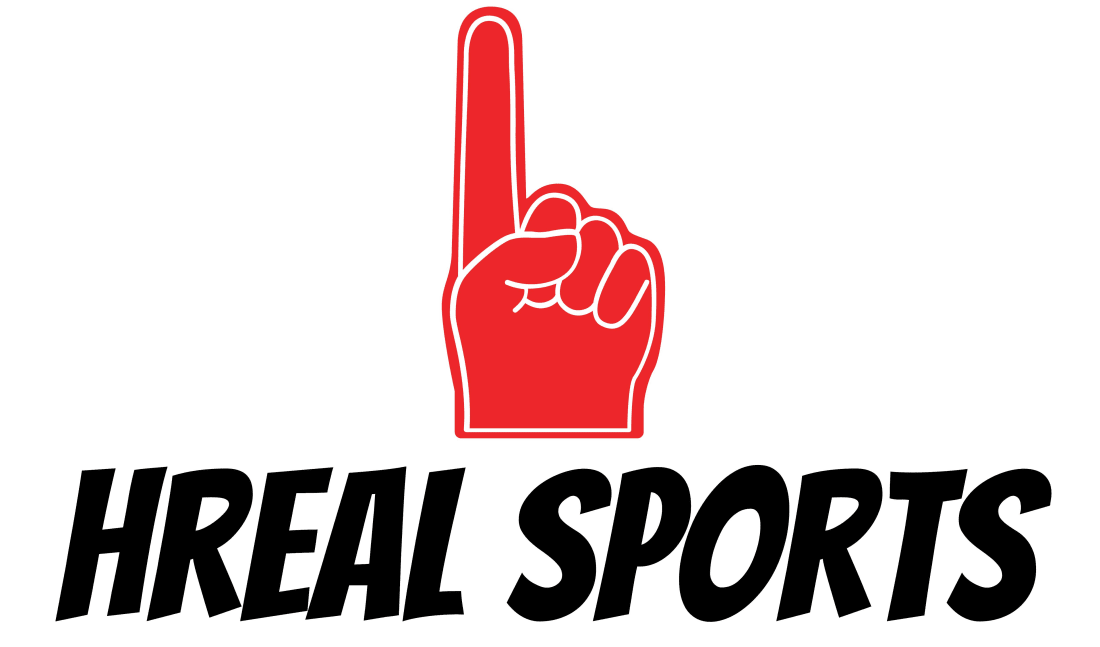
Welcome to Hreal Sports, a weekly newsletter written by Patrick Hruby about sports things that don’t stick to sports. Sign up and tell your friends!
Imagine this. The year is 2023. A much-discussed California law permitting many of the state’s college athletes to profit from the use of their names, images, and likenesses (NILs)—despite National Collegiate Athletic Association amateurism rules to the contrary—has just gone into effect.
Taking advantage, Stanford University’s star quarterback announces a six-figure endorsement deal with a Bay Area software maker. At a celebratory press conference, the company and athlete unveil their new marketing campaign, built around the player’s photo and the slogan “Data. Driven.”
The quarterback’s agent smiles. News cameras record the scene. After decades of economic exploitation at the hands of the NCAA and its member schools, campus athletes are one step closer to being free to be paid for their work, just like everyone else in America. Pay Day, reads one headline. Show Them The Money, reads another. Viva la revolucion!
The next morning, Stanford issues a press release. In order to comply with NCAA rules, it reads, the quarterback will be held out of competition indefinitely.
The quarterback sues, seeking a court order that will force the school to let him play. Motions are filed. The case is heard. A verdict is reached. That decision is appealed. More paperwork and billable hours follow.
The legal fight takes years—so long, in fact, that the quarterback exhausts his remaining eligibility and never plays another down for Stanford. National Football League teams shy away, reluctant to draft a perceived me-first player coming off an extensive layoff.
Meanwhile, the quarterback and his family have to pay for their lawyers, who don’t come cheap. And every other college athlete in California hoping to cash in on their NILs is stuck waiting on a resolution.
Finally, sometime in the late 2020s, an ultimate ruling comes down. Maybe schools like Stanford can lawfully bench athletes with endorsement deals to avoid NCAA penalties. Maybe they can’t. Either way, it takes roughly a decade from the initial passage of California’s NIL law for a single athlete to find out if they can collect a single check and still participate in college sports.
Some revolution.
“I think [the California law] is a bunch of bulls—t,” says Richard Johnson, an Ohio-based attorney who represented former Oklahoma State pitcher Andrew Oliver in a landmark 2009 case against the NCAA.
“The NCAA knows that it can sit back and do nothing for the next four years, because the law doesn’t go into effect until then. Then when there’s a lawsuit, they can kick the can down the road for another decade. That’s what they’ve always done.”
When California Gov. Gavin Newsom signed the bill into law last month alongside Los Angeles Lakers star LeBron James and others on James’ multimedia platform The Uninterrupted, he called out the Indianapolis-based trade association that oversees college sports. “I don’t want to say this is checkmate,” Newsom said. “But this is a major problem for the NCAA.”
Newsome’s not alone in his brio. Prior to the law’s passage, Sally Jenkins of the Washington Post said it would help dismantle the association’s “feudal castle,” “rotting beam by beam.” Following Newsom’s signature, San Francisco 49ers defensive back Richard Sherman said he hoped the law would “destroy the NCAA.”


But according to Johnson and fellow attorney Richard Karcher, a former minor league baseball player and associate professor at Eastern Michigan University, there’s a major problem with the legislation that purports to be a major problem for the NCAA: the actual text of the law has been written in ways that will make it hard for college athletes in California to collect NIL payments.
Well, at least not without first paying lawyers.
“We were both surprised by how poorly the statue was written,” Karcher says.
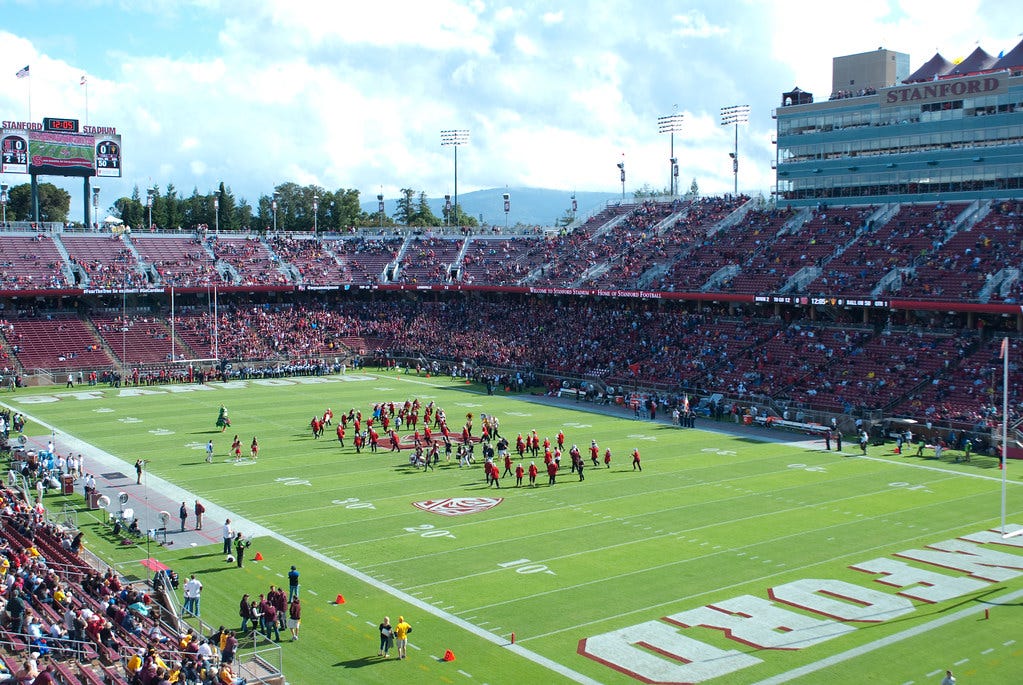
"first Stanford football game" by madichan is licensed under CC BY-NC 2.0
Karcher and Johnson aren’t exactly friends of the college sports program. The latter is a voluble NCAA critic. The former has argued that the association and its member schools exclusively profiting from multimillion-dollar sports broadcasting contracts qualifies as unjust enrichment—in non-legal terms: they’re stealing from athletes—and that big-time college football and men’s basketball players should be considered employees under federal labor law.
And that’s why both men are so frustrated with the California law. They think it could be—should be—much stronger.
Problem No. 1? The law doesn’t go into effect until January 1, 2023, even though campus athletes are being exploited today. The delay is intentional, meant to give the NCAA time to change its rules. But Johnson says that it mostly gives the association and its member schools more time to kick the can, enrich themselves, and lobby state lawmakers to water down the law.
“Four years makes it illusory,” he says. “Every day from now until four years from now, it can be revoked, revised, amended by the California state legislature and the governor.”
In 2023, Problem No. 2—the aforementioned Stanford quarterback scenario—will come into play. How? The law states that:
Schools can’t prohibit athletes from earning NIL compensation.
Earning said compensation can’t affect an athlete’s scholarship eligibility.
Conferences and the NCAA can’t prevent athletes from earning NIL compensation, nor prevent schools from participating in intercollegiate sports as a result of said compensation.
So Stanford can’t prevent our quarterback from signing an endorsement deal. Nor can it revoke his scholarship from doing do. And neither the Pac-12 nor the NCAA can boycott Stanford for having him on its football roster.
However, the NCAA can still punish the school if our quarterback plays in a game—after all, he’s ineligible under the association’s amateurism rules. Think vacated victories, monetary fines, recruiting restrictions, and lost scholarships, all things Stanford wants to avoid.
Moreover, if Stanford knows our quarterback is ineligible, then the NCAA’s “institutional control” doctrine requires the school to immediately remove him from competition.
“This won’t be a situation where somebody is getting paid money under the table and it comes out later,” Karcher says. “The endorsement occurs in public. And the school knows about it immediately.
“So what will happen is that the school will immediately sit the player. They just won’t take away their scholarship. The law pits the school against the NCAA.”
Can Stanford legally place an athlete in limbo? As written, California’s NIL law doesn’t expressly prohibit such a move. In order to get back on the field without giving up his endorsement deal, our quarterback will have to sue, asking judges to interpret the law and determine that benching players also is verboten.
That fight, Johnson and Karcher say, likely will take years, playing out in our overloaded court system at a glacial pace. And as it drags along, Stanford will continue to hold our quarterback out because of the NCAA’s Restitution Rule, a little-known association bylaw that works like this:
If any college athlete ruled ineligible by the NCAA is allowed to participate thanks to a court order, and said order is later vacated, stayed, or reversed, then the association can force the athlete's school to forfeit victories, surrender television revenue, pay fines, and endure postseason bans.
Until every last legal avenue is exhausted, Johnson and Karcher say, our quarterback will be out of luck. As such, the first athlete who signs a NIL deal may essentially be forfeiting the remainder of their campus sports career.
“The university will take position X on the law,” Karcher says. “The athlete will take position Y. The coach will say, I don’t give a s—t about your position, I have to hold you out. The the athlete has to pay a lawyer and go to court.”
“And don’t forget—for a lawyer, it comes down to how much money that endorsement is worth,” Johnson says. “A $2,000 deal might be meaningful for a kid, but you can’t build a case on a $2,000 or $20,000 or $200,000 deal. If it’s not in the seven figures, you won’t find a good contingency [fee] lawyer to do it.”
“Then it becomes a resources issue,” Karcher says. “The universities and NCAA benefit from the litigation process. They have lawyers and money. Most 18-21 year olds generally do not.”
The bottom line?
“California’s statue creates a system that makes it extremely difficult for the athlete to legally enforce,” Karcher says.
And that’s not the only problem Johnson and Karcher have with the California law. Another provision prevents college athletes from signing NIL deals that are “in conflict with a provision of the athlete’s team contract.”
In other words, if Stanford’s basketball team is outfitted by Nike, then its point guard can’t sign a shoe deal with Adidas.
“Think that through,” Johnson says. “If Stanford says none of our players can have contacts for athletic apparel, any soft drinks, any beer, all the categories Power Five schools already have ads in—that could leave athletes with little to nothing.”
The University of Alabama, for example, had sponsorship deals in 2015 with Nike, Regions bank, Toyota, Muscle Milk, Coca-Cola, Cooper Tires, Billy’s Sports Bar, and Golden Flake, “the official potato chip of the Crimson Tide for more than 50 years.”
“What we really could be talking about here are marginal payments,” Johnson says. “And that matters when you are unpaid. But there won’t be much advertising that can be done if the teams have ads for every category of consumer goods out there.”
In addition, the law expressly prohibits schools, conferences, and the NCAA from compensating prospective college athletes via NIL compensation—“why is that provision even in there?” Johnson says, noting that it only serves to codify existing amateurism rules into state law—whole also requiring agents or lawyers representing athletes in NIL deals to be licensed to practice in California.
“Again, why?” Johnson says. “If a kid comes from Oregon, he can’t have an Oregon lawyer? What if a California player wants to hire a New York lawyer because the NIL deal is based in New York?”
Barring future revision, Johnson and Karcher say, California’s NIL law may end up having more symbolic than practical impact on the lives and wallets of the state’s college athletes—not to mention the amateur economy it’s intended to upend.
“It’s almost like they are throwing a firecracker at Indianapolis,” Karcher says. “And NCAA headquarters is looking at them and saying, ‘firecrackers don’t travel that far, what are you guys doing?’”
More to the Story
When it comes to taking legislative aim at NCAA amateurism, California has company. A dozen other statehouses—including those in Florida and Washington—are considering similar bills. Here in Washington, D.C., Rep. Mark Walker (R-NC) already has introduced a House bill that would prevent the association from prohibiting NIL compensation on a national level.
Walker’s effort got a recent boost when Sen. Cory Booker (D-NJ), a presidential candidate and former college football player, released a detailed plan that castigated college sports for “price fixing” and “wage theft” promised to “fight for legislation to ensure that all college athletes have the right to profit off their NIL rights and hire agents without penalty.”
Last Wednesday, Sen. Mitt Romney (R-UT) joined the party, announcing at a college sports roundtable discussion that Walker’s bill has “a great deal of merit” and that he planned to study the issue before introducing legislation in the Senate.
“I know there are people who think we can hold this off,” Romney said. “We’re not going to make a change here. But the reality is Congress is going to act.
“We’re coming for you. We’re coming to help these young athletes in the future, and the athletes of today, make sure that they don’t have to sacrifice their time and sacrifice, in many cases, their bodies without being fairly compensated.”
With political pressure building, how will the NCAA respond? Here are four potential ways the association can fight back against lawmakers:
1. Go to Court
Prior to Newsom signing the California bill into law, the NCAA sent him a letter calling the proposed legislation “unconstitutional”—a hint that the association could sue the state in federal court under the Commerce Clause of the U.S. Constitution, which holds that only Congress has the power to regulate commerce among states.
According to Sports Illustrated legal analyst Michael McCann, the NCAA, the Pac-12 and Mountain West conferences, and even California schools themselves could argue that:
the broadcasting of games across state lines, the shipping of collegiate apparel and merchandise across lines and the interstate travel of players and coaches to play games all constitute interstate commerce.
Would a Commerce Clause challenge be successful? As McCann points out, this sort of defense has worked for the NCAA before: in 1993, a federal judge overturned a Nevada state law requiring the association to provide schools, employees, athletes, and boosters with procedural due process protections during enforcement actions that could result in sanctions.
In that case, Judge Ferdinand Fernandez reasoned that in order to apply equal rules across the 50 states, the NCAA would be required to adopt the rules of Nevada for every state—effectively giving Nevada the power to control commerce beyond its state lines. The association could easily make the same case against California.
On the other hand, a Commerce Clause challenge would be an extremely high-profile reminder that major college sports are a deeply an unabashedly commercial activity, undercutting the NCAA’s concurrent, ongoing claims in federal antitrust court that it should be allowed to fix prices and violate the Sherman Act because campus athletics are actually about education and not making money.
2. Go to Congress
The NCAA and its member schools are united by one thing: a burning desire to keep the money generated by college sports in their own pockets. Otherwise, they don’t particularly like or trust each other. The last thing they want is a scenario in which multiple states have multiple variations of NIL laws, with different legislatures competing to offer athletes the best deal—the better to boost the recruiting-talent-and-winning-sportsball-games prospects of State U.
One way to avoid that outcome? Petition Congress to create a national, uniform NIL law. One that’s as favorable as possible to the NCAA, placing plenty of restrictions on athletes while preserving the existing lopsided balance of economic power. No touching the TV money. No deals that conflict with athletic department deals. Everything must be approved by school officials. No deals involving boosters. All money goes into escrow, and you have have it after you graduate.
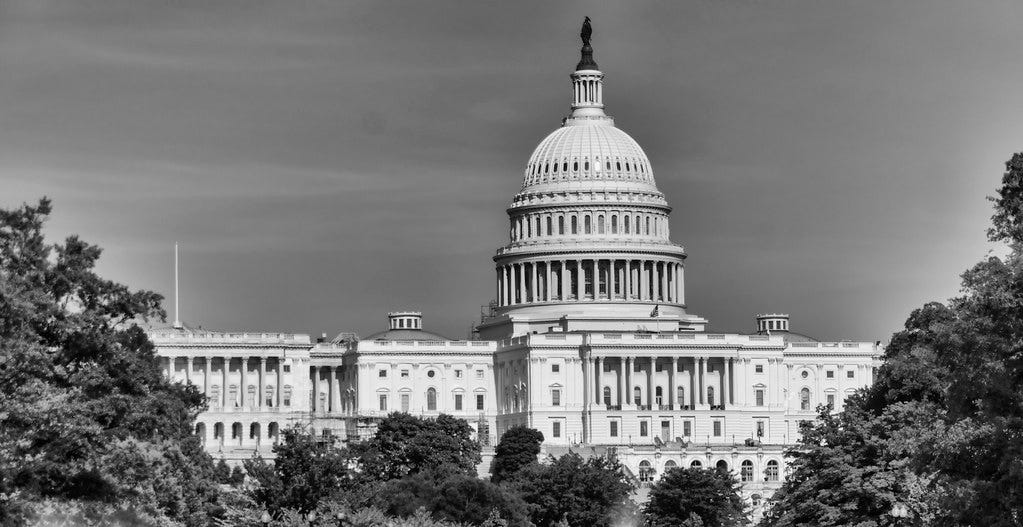
"The law hit the floor" by Victor Prada is licensed under CC BY-NC-SA 2.0
The NCAA is well-positioned to make a Capitol Hill play. The association spent $580,000 lobbying Congress in 2014; that same year, it also hired outside lobbyists for the first time, reportedly contracting a high-powered K Street firm to work on issues related to what its disclosure forms called the “welfare of student-athletes.” Major public and private universities also have a powerful and longstanding presence in the Capitol. And as I wrote in 2017, athletic directors at the country’s biggest sports schools have their own trade group, LEAD1, headed by former Congressman Tom McMillen, complete with its own PAC.
For the powers-that-be in college sports, the halls of Congress can be considered akin to a home court:
Many of the association's member schools already have full-time federal lobbyists; better still, they have institutional clout. What member of Alabama's Congressional delegation would want to take a public stand against the University of Alabama, especially against the wishes of that school's beloved athletic program? Some lawmakers are alumni of the very schools that will be lobbying them—and if they're sports fans, they're likely to be watching the big game from a luxury box. For them, the system is working just fine.
When schools squawk, lawmakers listen. Case in point? In 1986, the Internal Revenue Service ruled that donations to school athletic departments to purchase tickets were no longer tax-deductible. Sen. Russell Long from Louisiana and Rep. J.J. Pickle from Texas promptly slipped an amendment into the larger Tax Reform Act of that year to exclude Louisiana State University and the University of Texas from the IRS's decision. When other colleges and universities realized they had been left out, they were furious. As McMillen tells the story, athletic directors personally lobbied Congress, which responded by creating 80 percent deduction for tickets—one that applied to all schools, and remains in effect today. "That's the last time the athletic directors came to Washington," he says. "So this is not new. All we're doing is a remobilization drill so that is something comes up, we'll be ready."
In his remarks last week, Romney signaled sympathy for the idea of amateurism—and with that, a potential willingness to cut a friendly deal with the NCAA. “I do believe we have to take action,” he said. “I’m convinced that we can adjust and we can address the extraordinary unfairness without in any way sacrificing the amateur nature of college sports or its attractiveness and impact on the American public.”
However, there’s a catch. In D.C., cutting deals means getting and giving—or, to use a phrase that’s both timeless and timely, a quid pro quo. What does the NCAA have to offer Congress in exchange for wading into a controversial, divisive, and high-profile issue that’s as likely to get members criticized as praised, and draw attention to the fact that lawmakers are bargaining with one of America’s least-liked organizations to the probable detriment of college athletes? Absolutely nothing. And besides, lawmakers from both sides of the aisle seem increasingly unsympathetic to the association’s cause.
If the NCAA goes to Washington, it will be betting that it can secure a law it likes—but gambling that it ends up with one that it doesn’t.
3. Co-opt Change
Back in May, the NCAA announced the creation of a committee to examine the association’s NIL rules and potentially propose changes. Expected to deliver a report to association leadership later this month, the committee could attempt to get in front of California and other states by recommending athlete NIL rules limited enough to leave most of the money and all of the control in the hands of schools, but expansive enough to satisfy grumbling lawmakers.
But that’s a tough needle to thread. While something like the so-called “Olympic model” seems like a reasonable compromise—let athletes earn whatever they can from third-parties, but don’t declare them school employees and keep them away from the broadcast and ticket cash—the NCAA still has to worry about future antitrust suits seeking to eliminate amateurism altogether. The more money athletes make without college sports falling apart, the harder it becomes for the association’s lawyers to bullshit federal judges by insisting that college sports will fall apart if athletes are allowed to make money.
4. Take Ball, Go Home
The NCAA has warned that once California’s law goes into effect, the state’s schools will become ineligible to participate in NCAA championships. Similarly, Ohio State athletic director Gene Smith—a member of the aforementioned association NIL committee—told USA Today that he plans to not schedule games against California schools for dates after Jan. 1, 2023.
Will the NCAA and its loyal members follow through and effectively boycott California? Will they do the same to other states that pass similar laws? Don’t count on it. California has the world’s fifth-largest economy, bigger than the United Kingdom. And states like New York and Florida are no financial slouches, either. Schools don’t love amateurism for its own sake; they love it because it pays. If and when it stops doing so, expect them to adjust accordingly.
Department of Shameless Self-Promotion
I published a pair of articles since the last edition of Hreal Sports:
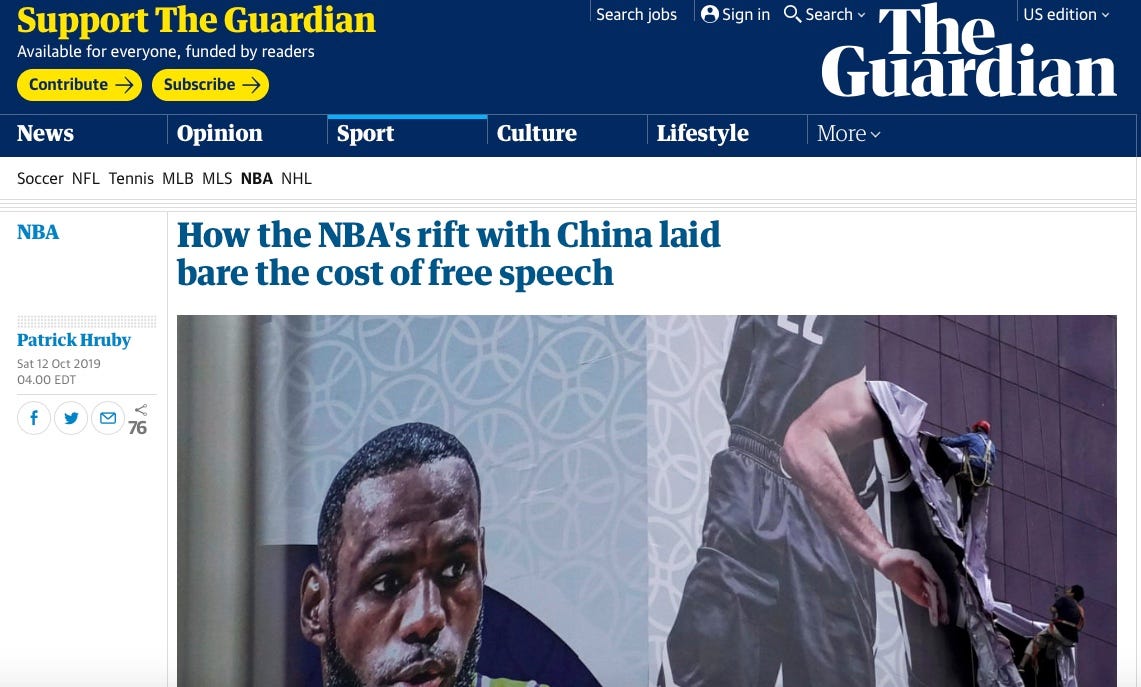
“How the NBA's rift with China laid bare the cost of free speech,” The Guardian
The world’s premier basketball league has spent decades cultivating the multibillion-dollar Chinese market, but the fallout from a single tweet has threatened to upset it all. Just how much does the NBA stand to lose?
Earlier this week, a league source told the Houston Chronicle that fallout from Morey’s tweet could cost the Rockets between $10m and $25m.
Meanwhile, Yahoo Sports reported that at least five NBA teams already were planning for the possibility that the league’s salary cap for the 2020-21 season could drop between 10% and 15% without expected revenue from China, a loss of roughly $17m per team.
Long-term losses for the NBA could be far greater. Like many international firms, the league is betting on the continued growth of China’s middle class, which is expected to reach 550m people in three years – more than one-and-a-half times the entire current US population.
When Fertitta purchased the Rockets for $2.2bn in 2017 and when Tsai recently bought the Nets at a valuation of $2.35bn, sale prices were bolstered by the prospect of an increasingly robust Chinese basketball market.
“There’s still room for growth there, and for engaging fans,” Delpy Neirotti said. “There’s still room for growth in terms of Internet and social media followers, too.”
If you need a good overview-cum-primer on how and why the NBA and China are at odds, this will bring you up to speed.
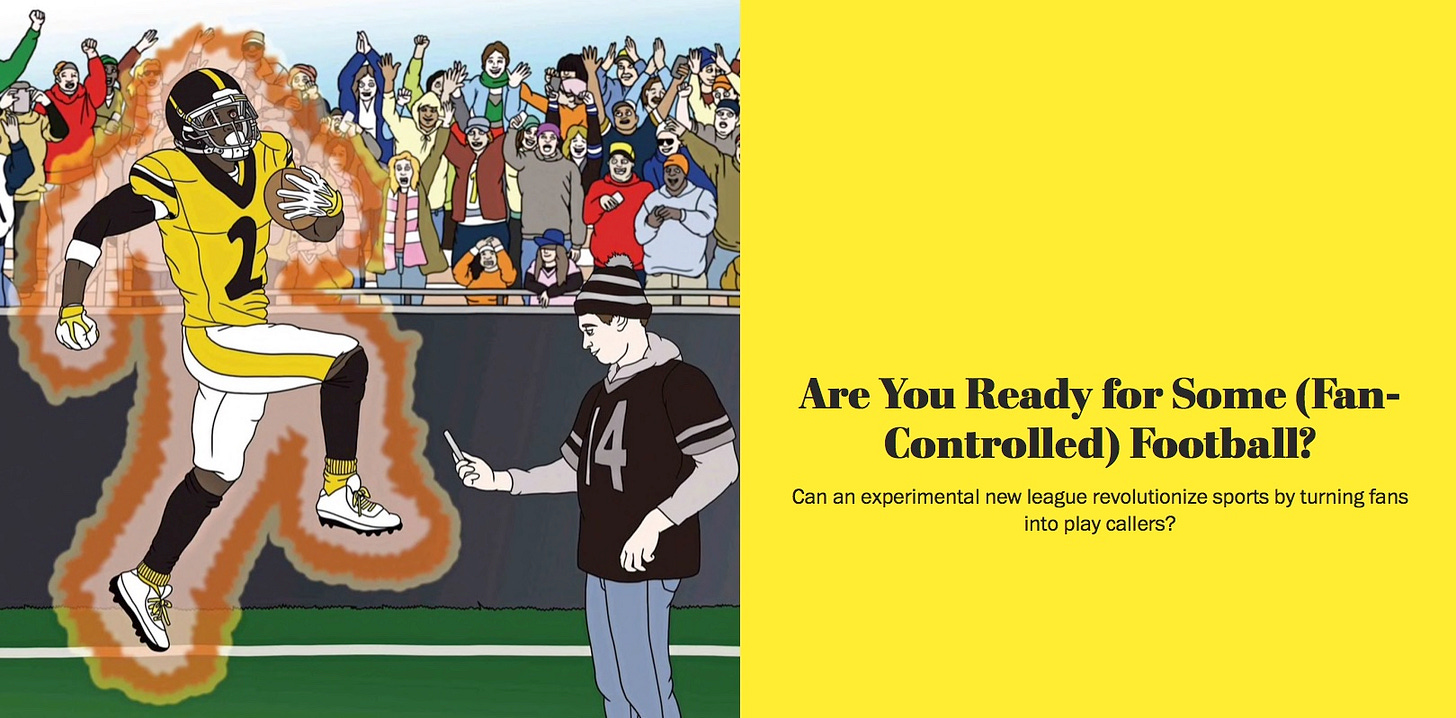
“Are You Ready for Some (Fan-Controlled) Football?,” The Washington Post Magazine
Can an experimental new league revolutionize sports by turning fans into play callers?
When it comes to determining who does what, traditional leagues are as top-down as a Politburo. Owners, executives, coaches and other Professional Sports Knowers call the shots. Meanwhile, fans call in to talk radio to second-guess those choices. The closest Steve From Arlington ever gets to being in charge of the Washington Redskins is through fantasy sports — and the key word there is “fantasy.”
The FCFL aims to flip that dynamic on its head. Scheduled to debut in early summer 2020 in Las Vegas — with teams playing 7-on-7 inside a customized arena attached to a casino — the league combines the all-American habit of democratic self-determination with the Silicon Valley ethos of an app for everything. The target market? Any football fan who has ever watched helplessly as their favorite squad botched a trade, blew a draft pick, hired the wrong coach, fired the right one, or punted when they should have gone for a first down. In other words, every football fan.
“When I first got involved, people would ask, ‘So, is this a new video game?’ ” says Andy Dolich, 72, the league’s chief operating officer and a former executive with multiple sports franchises, including the San Francisco 49ers and Washington Capitals. “I would say, ‘No, this is real human beings.’ And then it’s, ‘Holy crap!’ Well, the ‘holy crap’ is what got me interested. Fans believe they are smarter than the owner, the general manager, the coach. Here, they’ll have the ability to see if they really are.”
I had an absolute blast reporting this piece—and conceptually, I think the upcoming Fan Controlled Football League has a smart and unique approach. However, the economics of minor league football are very rough; I’m eager to see if the league can create something groundbreaking and sustainable.
We Here For You
Thanks so much for reading—Hreal Sports is only two editions old, and I’m already thrilled by the responses I’ve gotten. Even from indignant University of North Carolina fans on Twitter:

In the coming weeks, I plan to cover private equity’s role in the destruction of journalism and the ongoing and arguably irresponsible use of the painkiller Toradol in the NFL. I’ll also be following up on UNC’s official response-slash-non-response to the issues raised in last week’s newsletter and a larger and concurrent investigation from The Athletic.
That said, I want to hear from you. What topics do you want covered? What formats do you want to see? What other questions do you have? Drop me a line and let me know.
This has been Hreal Sports, a weekly newsletter written by Patrick Hruby about sports things that don’t stick to sports. If you have any questions or feedback, contact me at my website, www.patrickhruby.net. And if you enjoyed this, please sign up and share with your friends.



